Evaluation Techniques for Shale Oil Lithology and Mineral Composition Based on Principal Component Analysis Optimized Clustering Algorithm
Abstract
:1. Introduction
2. Lithology Determination and Determination of the Mineral Fraction of the Formation
2.1. Determination of Reservoir Lithology
2.2. Determination of Mineral Fractions
3. Qualitative Lithology Identification Techniques Based on Principal Component Analysis Optimized Clustering Algorithms
3.1. Optimal Selection of Sensitive Parameters Based on Principal Component Analysis Techniques
3.2. Lithology Identification Techniques for Logging Based on Cluster Analysis
4. Quantitative Calculation of Mineral Composition
4.1. Calculation of Shale Content Based on Combination Method
- (1)
- Calculation of shale content by neutron-density crossplot
- (2)
- Calculation of shale content by reconstructing uranium-free gamma curve method
4.2. Optimisation-Based Multi-Mineral Model Approach to Calculate Mineral Content
5. Conclusions
Author Contributions
Funding
Data Availability Statement
Conflicts of Interest
References
- Pan, T.; Ma, X.; Xie, A.; Gao, Z. Optimization of BP neural network model in sand and conglomerate lithology identification using principal component analysis. Xinjiang Geol. 2020, 38, 417–420. [Google Scholar]
- Kong, Q.; Yang, C.; Li, H.; Geng, C.; Deng, J. A lithology identification method based on graph-theoretic clustering and minimum proximity algorithm—An example of carbonate reservoirs of the Leikoupo Formation in the western Sichuan Basin. Pet. Nat. Gas Geol. 2020, 41, 884–890. [Google Scholar]
- Fang, Y.; Zhang, W.Y.; Ma, F.; Cheng, L.F.; Shi, F. Global distribution and development status of shale oil resources. Miner. Conserv. Util. 2019, 39, 126–134. [Google Scholar] [CrossRef]
- Yang, L.; Jin, Z. Global shale oil development and outlook. China Pet. Explor. 2019, 24, 553–559. [Google Scholar]
- Liu, F.; Zhu, X.; Liang, J.; Chen, G.; Liu, T. Characteristics of deep-water gravity flow petrographic development and its reservoir properties in the Yanchang Formation, Ordos Basin. Mar. Geol. Front. 2020, 36, 46–55. [Google Scholar] [CrossRef]
- EIA. Technically Recoverable Shale Oil and Shale Gas Resources: An Assessment of 137 Shale Formations in 41 Countries Outside the United States; US Department of Energy: Washington, DC, USA, 2013. [Google Scholar]
- EIA. Annual Energy Outlook 2017 with Projections to 2050; US Energy Information Administration: Washington, DC, USA, 2017. [Google Scholar]
- Ma, L.; Xiao, H.; Tao, J.; Su, Z. An intelligent lithology classification method based on gradient boosting decision tree algorithm. Oil Gas Geol. Recovery 2022, 29, 21–29. [Google Scholar] [CrossRef]
- Xu, H.; Cheng, D.; Xu, Y.H.; Yao, K.; Qiu, F.; Wu, X.; Lin, P. Formation lithology identification based on trenchless slurry performance testing system with weakly supervised learning. Geol. Sci. Technol. Bull. 2021, 40, 293–301. [Google Scholar] [CrossRef]
- Xu, H.; Yao, K.; Cheng, D.; Song, Q.; Ma, Z.; Zhu, X.; Wu, X.; Zhao, G.; Cai, X. Identification of formation lithology based on trenchless drilling inspection system and random forest. Geol. Sci. Technol. Bull. 2021, 40, 272–280. [Google Scholar] [CrossRef]
- Gu, Y.F.; Zhang, D.Y.; Bao, Z.D. Identification of lithology in dense sandstone reservoirs using a hybrid model CRBM-PSO-XGBoost. Pet. Nat. Gas Geol. 2021, 42, 1210–1222. [Google Scholar]
- Xu, Z.H.; Ma, W.; Lin, P.; Shi, H.; Liu, T.H.; Pan, D.D. Intelligent recognition of lithology based on rock image migration learning. J. Appl. Basic Eng. Sci. 2021, 29, 1075–1092. [Google Scholar] [CrossRef]
- Li, X.; Fan, X.Y.; Wang, Z.F.; Li, Y.X.; Chen, K.G.; Ma, X.L. Logging lithology identification method research based on PSO-SVM: A case study of Paleozoic (Pz) reservoir in K oil field, South Turgay Basin, Kazakhstan. Prog. Geophys. 2022, 37, 617–626. [Google Scholar] [CrossRef]
- Gu, Y.F.; Zhang, D.Y.; Bao, Z.D.; Guo, H.X.; Zhou, L.M.; Ren, J.H. Lithology identification of dense sandstone formations using GS-LightGBM machine learning model. Geol. Sci. Technol. Bull. 2021, 40, 224–234. [Google Scholar] [CrossRef]
- Ye, T.; Niu, C.; Wang, Q.; Gao, K.; Sun, Z.; Chen, A. Identification of paleosubduction metamorphic lithologies by the “composition-structure” classification method: An example from the Bohai Sea. Rocky Reserv. 2021, 33, 156–164. [Google Scholar]
- Zhou, H.; Zhang, C.; Zhang, X.; Wu, Z.; Ma, Q. A capsule network-based lithology identification method for carbonate reservoirs. Nat. Gas Geosci. 2021, 32, 685–694. [Google Scholar]
- Wang, Z. Research on Lithology Recognition Method Based on Convolutional Recurrent Neural Network and Integrated Learning; Yanshan University: Qinhuangdao, China, 2021. [Google Scholar] [CrossRef]
- Gu, Y.F.; Zhang, D.Y.; Bao, Z.D. PSO-GBDT identification of lithology in dense sandstone reservoirs: An example of the long 4+5 section in the western Ji Plateau oilfield. Miner. Rock Geochem. Bull. 2021, 40, 624–634. [Google Scholar] [CrossRef]
- Zhao, J.; Wang, W.M.; Yang, Z.D.; Zhang, M.L. Lithology identification method of volcanic rocks based on DBN model: An case in Chepaizi area. Prog. Geophys. 2022, 37, 328–337. [Google Scholar] [CrossRef]
- Wu, Z.Y.; Zhang, X.; Zhang, C.H.L.; Wang, H.Y. LSTM recurrent neural network-based lithology identification method. Rocky Oil Gas Reserv. 2021, 33, 120–128. [Google Scholar]
- Yuan, B.; Weijie, C.; Jin, Z.; Lijuan, L.; Feng, L.; Yongchang, G.; Baifa, Z. Addition of alkaline solutions and fibers for the reinforcement of kaolinite-containing granite residual soil. Appl. Clay Sci. 2022, 228, 106644. [Google Scholar] [CrossRef]
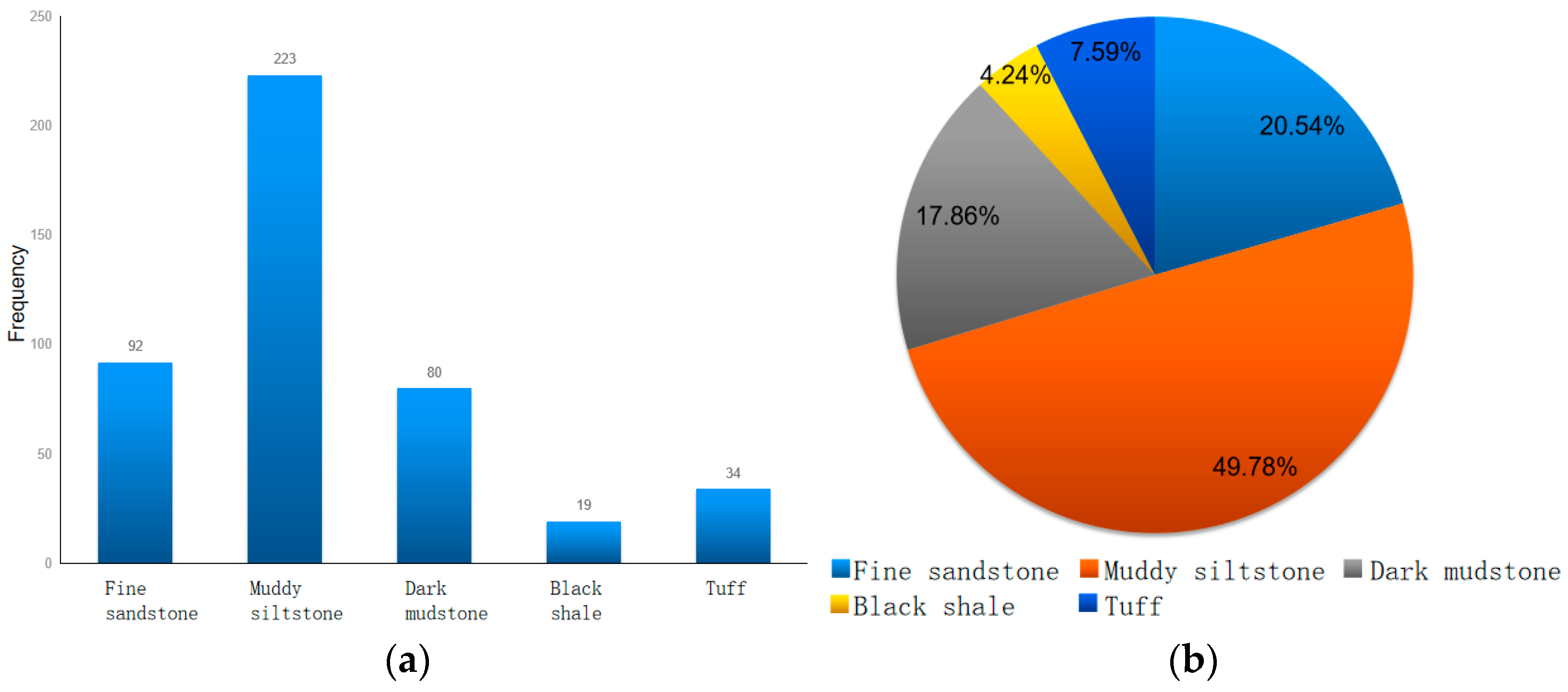

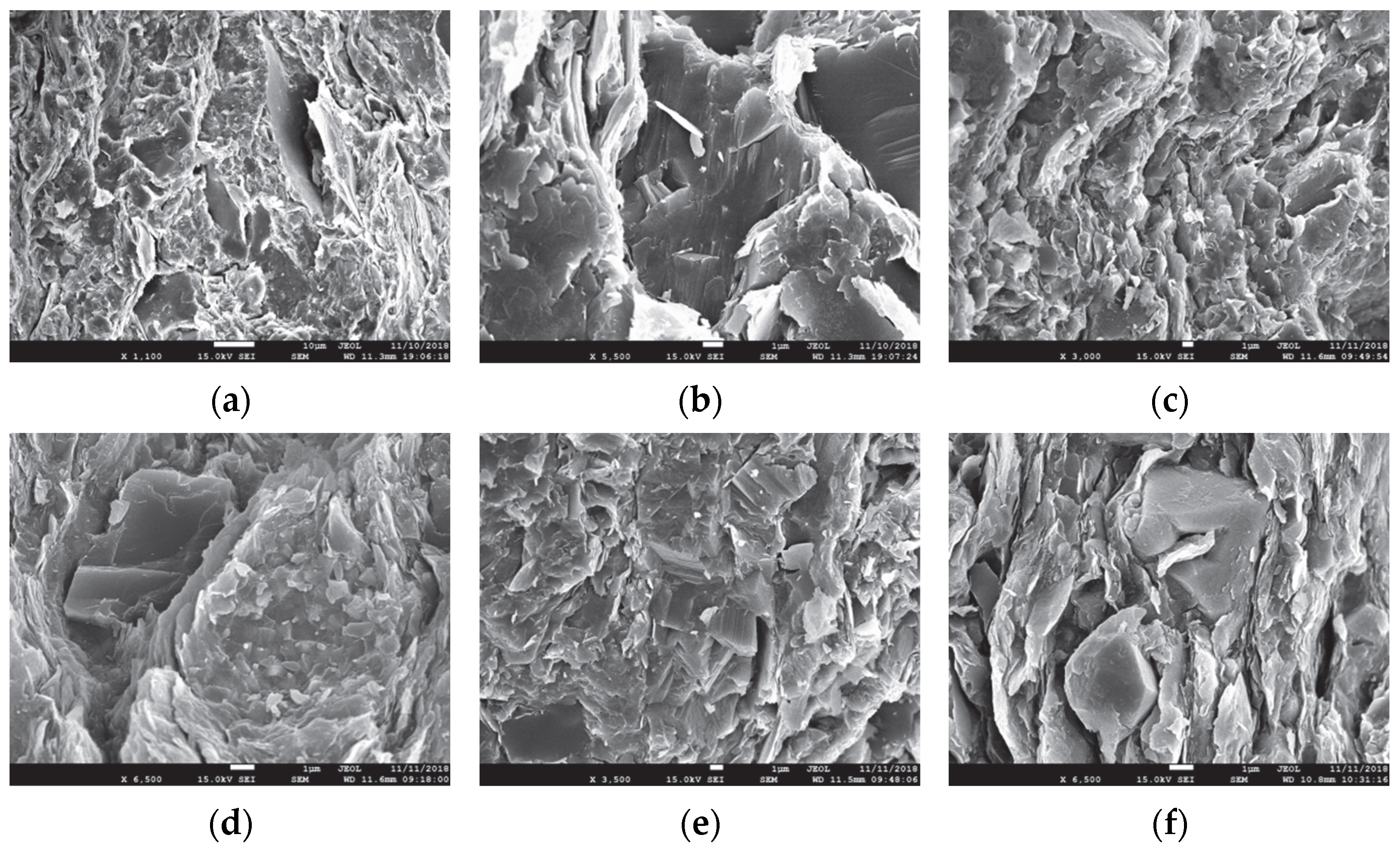
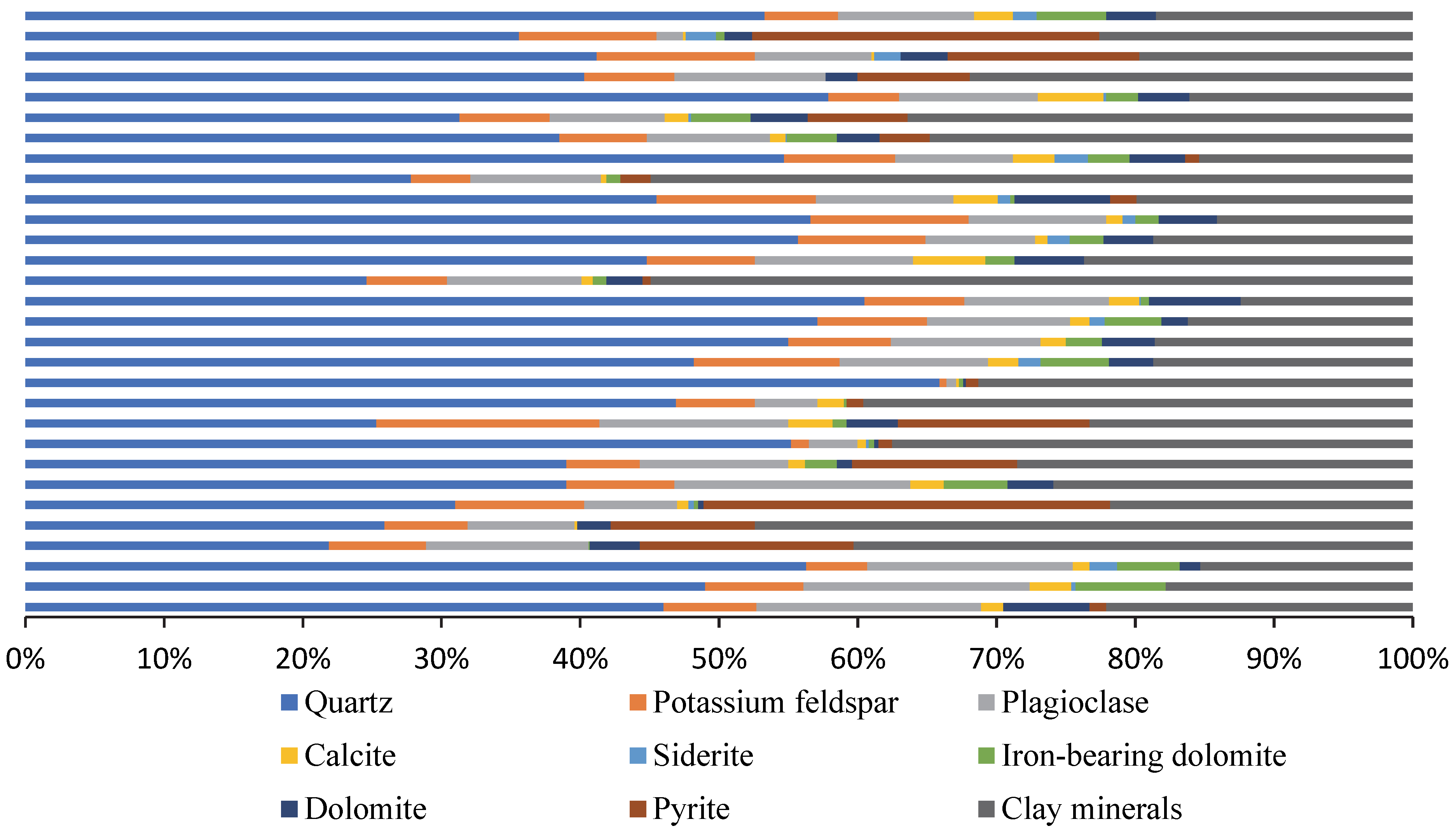
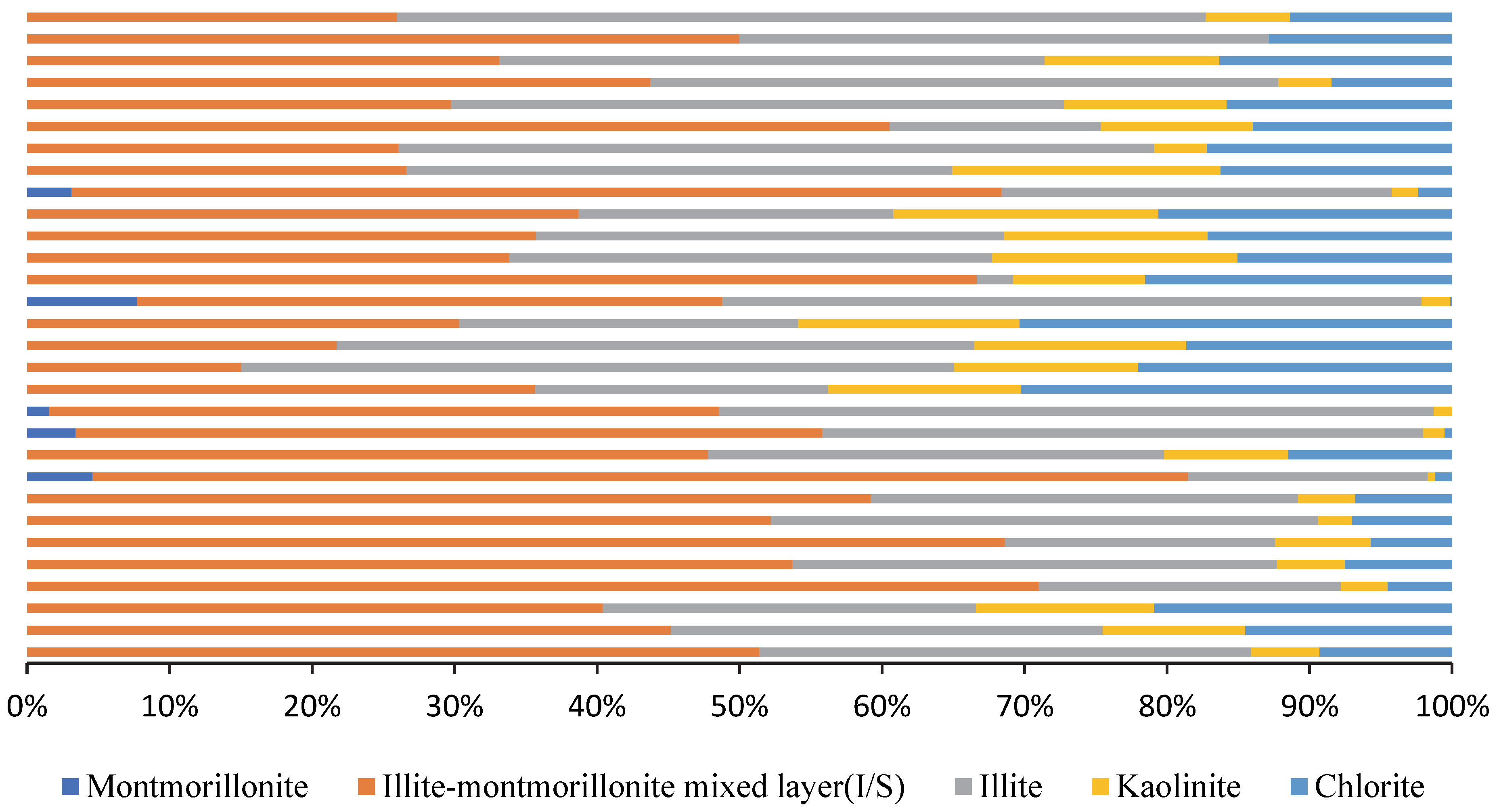


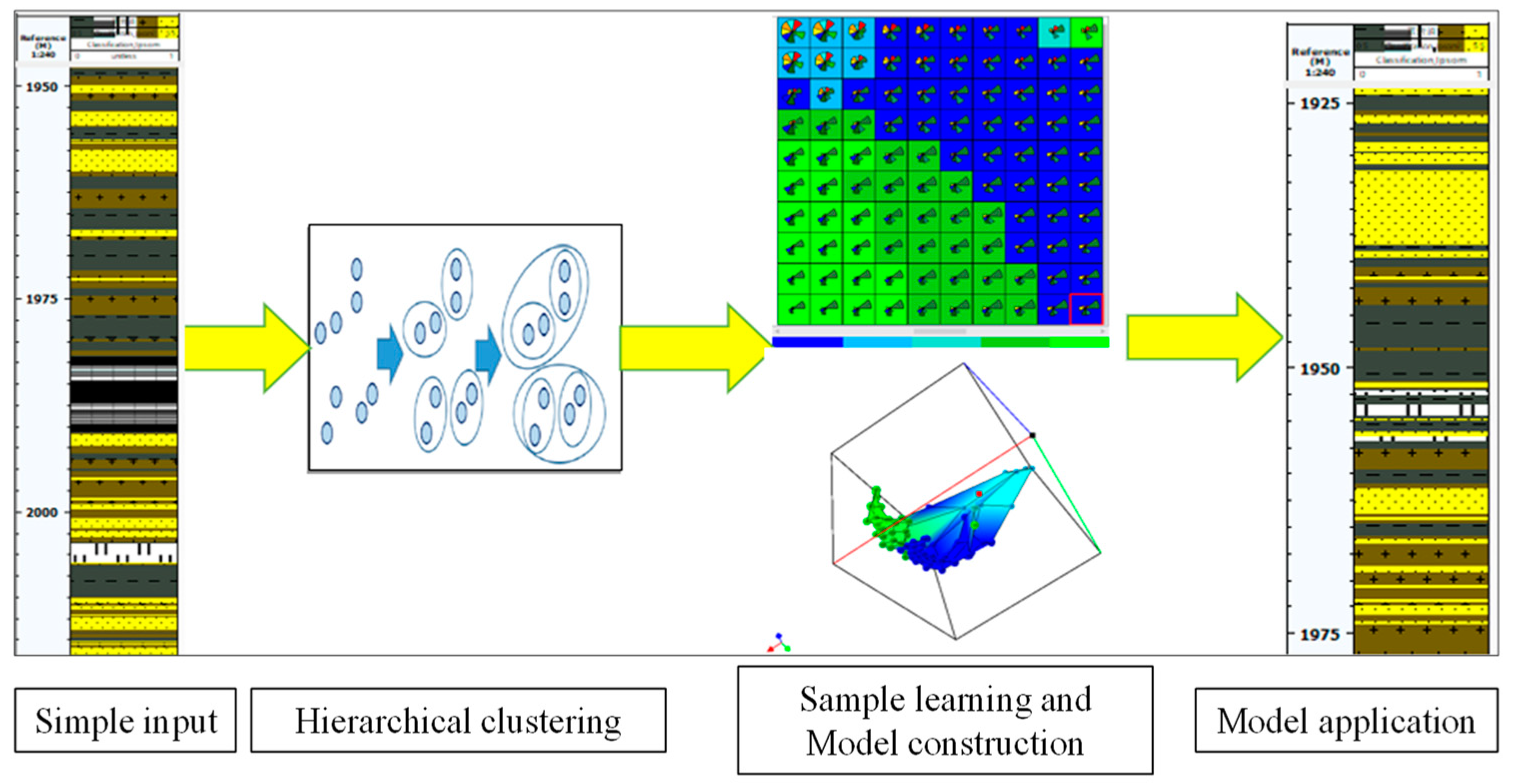

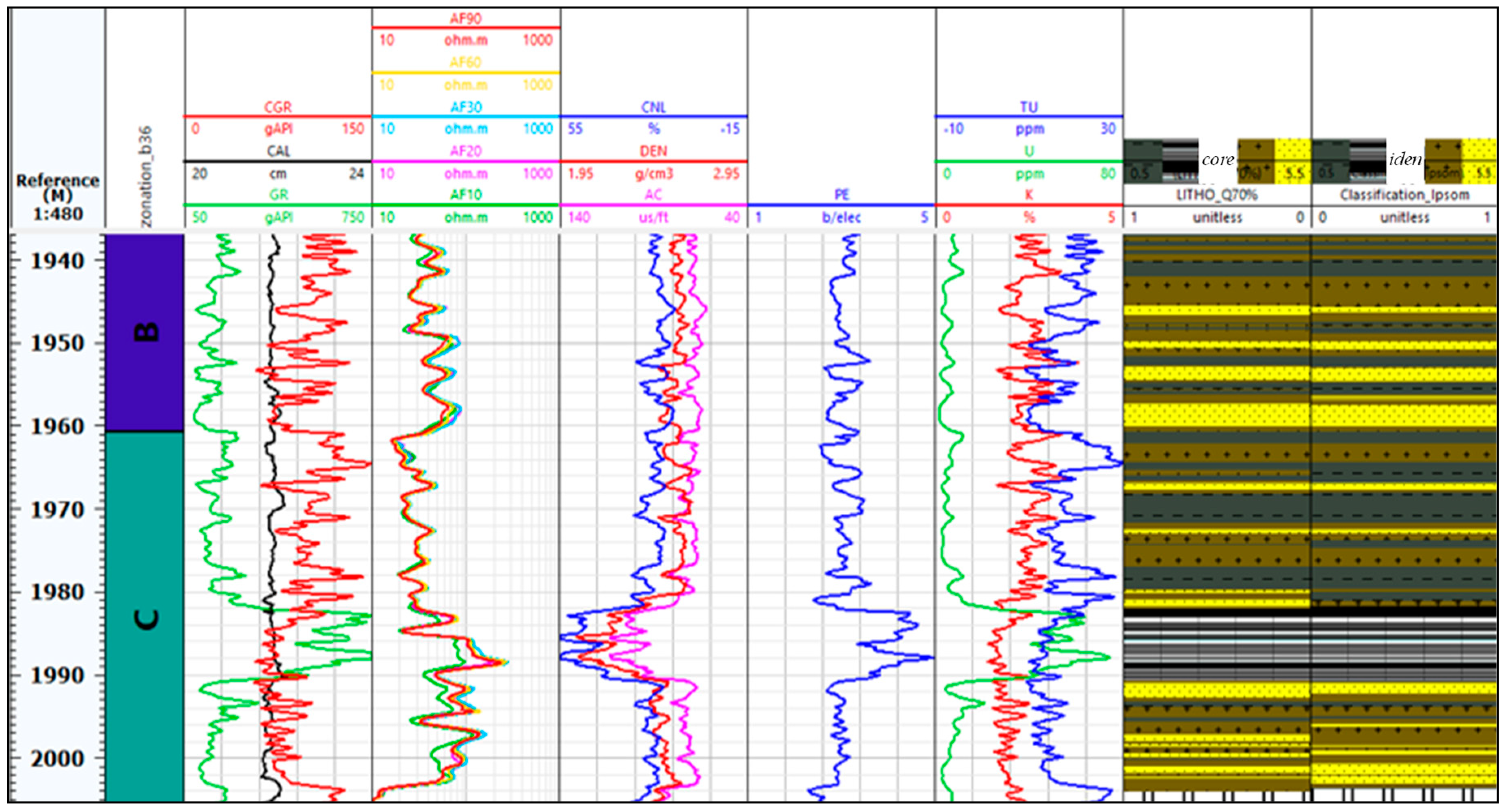

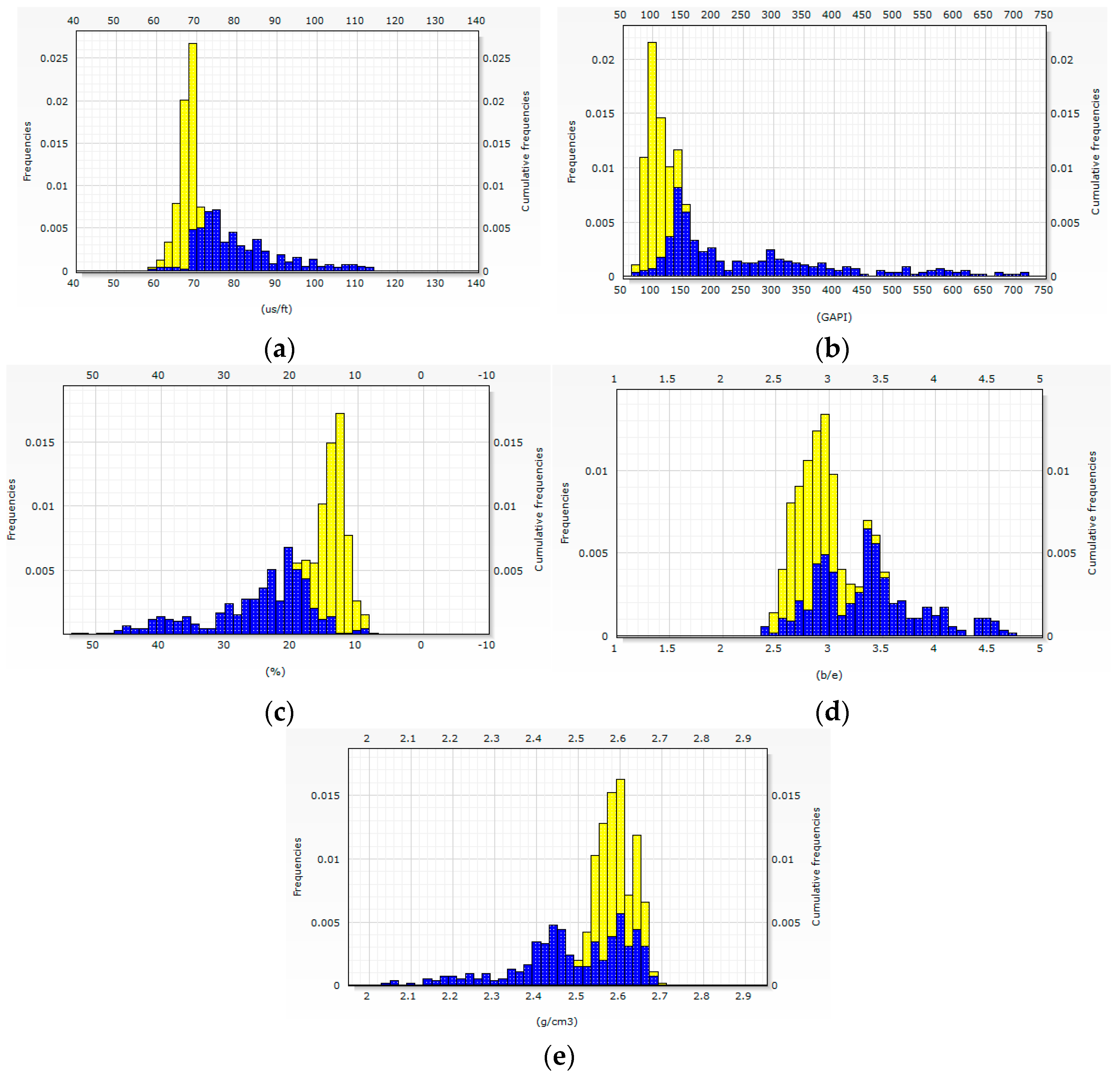


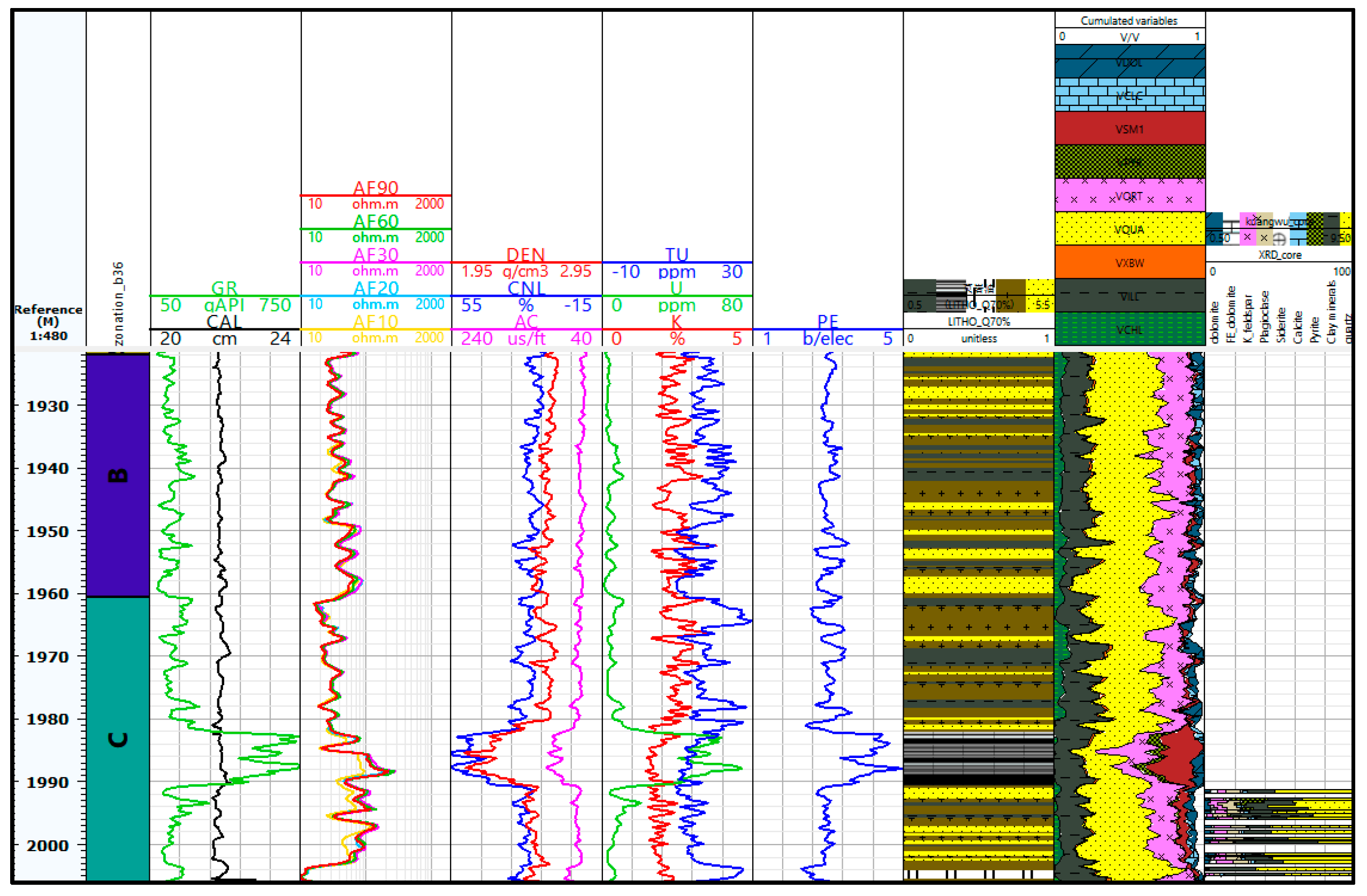
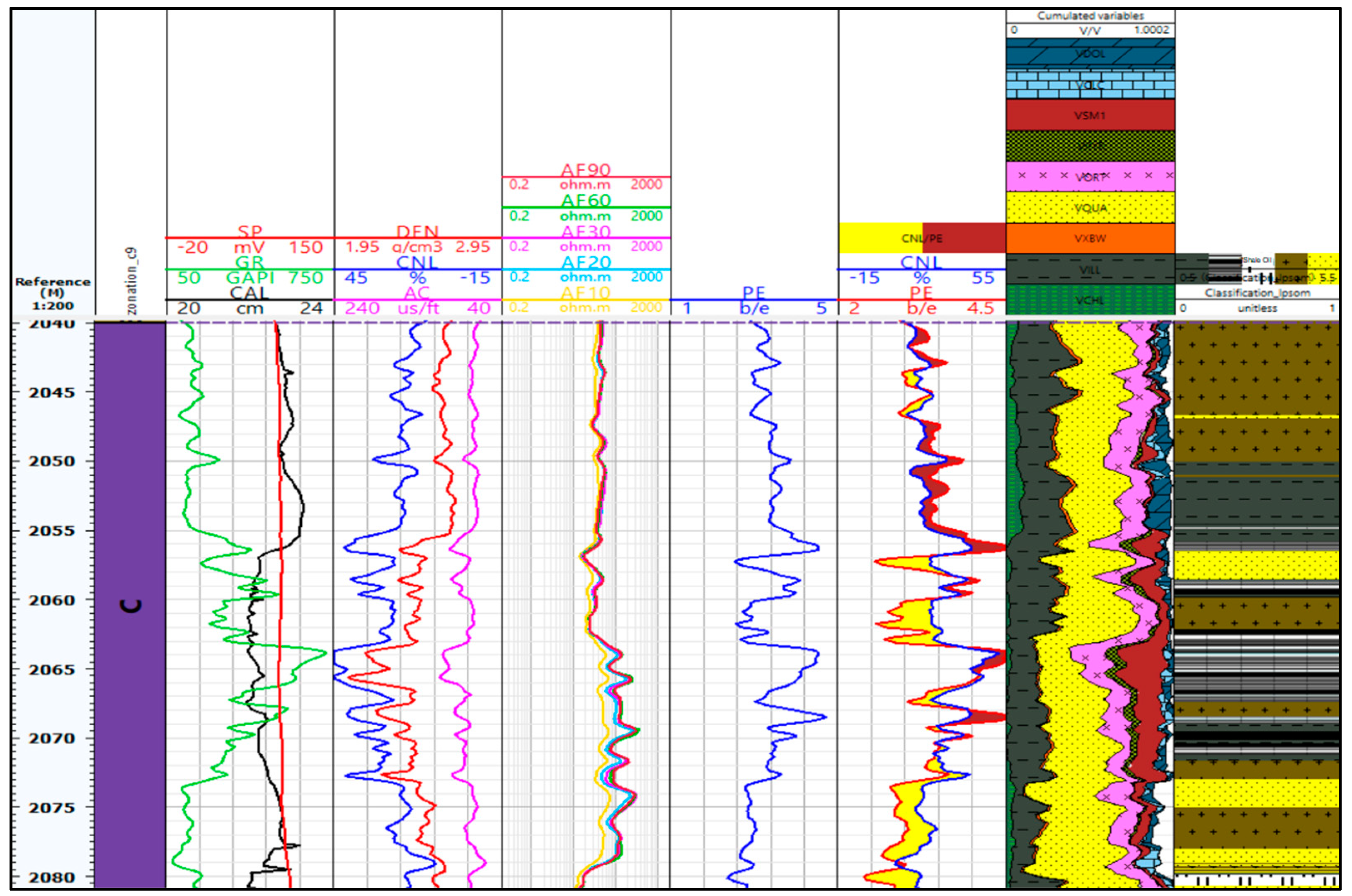
| Bulk Density | Comprehension Slowness | Gamma Ray | Neutron Porosity | Photoelectric Factor | Deep Resistivity | Shallow Resistivity | Potassium Concentration | Thorium Concentration | Uranium Concentration | |
|---|---|---|---|---|---|---|---|---|---|---|
| Bulk Density | 1 | −0.693173 | −0.737776 | −0.560614 | −0.153228 | −0.645156 | −0.540367 | 0.274423 | 0.117068 | −0.804864 |
| Comprehension Slowness | −0.693173 | 1 | 0.805944 | 0.948787 | 0.610787 | 0.266069 | 0.0723262 | 0.21398 | 0.260662 | 0.772366 |
| Gamma Ray | −0.737776 | 0.805944 | 1 | 0.8082 | 0.644885 | 0.429516 | 0.253071 | 0.140882 | 0.269512 | 0.972025 |
| Neutron Porosity | −0.560614 | 0.948787 | 0.8082 | 1 | 0.761449 | 0.221603 | 0.0243947 | 0.300354 | 0.308405 | 0.759762 |
| Photoelectric Factor | −0.153228 | 0.610787 | 0.644885 | 0.761449 | 1 | 0.11066 | −0.0334943 | 0.402085 | 0.216005 | 0.598149 |
| Deep Resistivity | −0.645156 | 0.266069 | 0.429516 | 0.221603 | 0.11066 | 1 | 0.89983 | −0.314645 | −0.336595 | 0.534918 |
| Shallow Resistivity | −0.540367 | 0.0723262 | 0.253071 | 0.0243947 | −0.0334943 | 0.89983 | 1 | −0.320226 | −0.398188 | 0.357767 |
| Potassium Concentration | 0.274423 | 0.21398 | 0.140882 | 0.300354 | 0.402085 | −0.314645 | −0.320226 | 1 | 0.703384 | −0.0528857 |
| Thorium Concentration | 0.117068 | 0.260662 | 0.269512 | 0.308405 | 0.216005 | −0.336595 | −0.398188 | 0.703384 | 1 | 0.0649356 |
| Uranium Concentration | −0.804864 | 0.772366 | 0.972025 | 0.759762 | 0.598149 | 0.534918 | 0.357767 | −0.0528857 | 0.0649356 | 1 |
| Medium Natural Gamma Siliceous Shale | High Natural Gamma Siliceous Shale | High Natural Gamma Clayey Shale | Extra High Natural Gamma Siliceous Shale | High Natural Gamma Tuffaceous Shale |
|---|---|---|---|---|
 |  |  |  |  |
| AC | AF20 | AF90 | CNL | DEN | GR | PE | CGR | |
|---|---|---|---|---|---|---|---|---|
| AC | 1 | |||||||
| AF20 | 0.307215 | 1 | ||||||
| AF90 | 0.414528 | 0.96554 | 1 | |||||
| CNL | 0.952085 | 0.270417 | 0.384129 | 1 | ||||
| DEN | −0.83244 | −0.49978 | −0.58967 | −0.74327 | 1 | |||
| GR | 0.910569 | 0.291836 | 0.396808 | 0.922276 | −0.81952 | 1 | ||
| PE | 0.664827 | 0.107605 | 0.17078 | 0.779276 | −0.33254 | 0.713711 | 1 | |
| CGR | 0.309785 | −0.3616 | −0.33071 | 0.420375 | 0.009589 | 0.335664 | 0.414639 | 1 |
Disclaimer/Publisher’s Note: The statements, opinions and data contained in all publications are solely those of the individual author(s) and contributor(s) and not of MDPI and/or the editor(s). MDPI and/or the editor(s) disclaim responsibility for any injury to people or property resulting from any ideas, methods, instructions or products referred to in the content. |
© 2023 by the authors. Licensee MDPI, Basel, Switzerland. This article is an open access article distributed under the terms and conditions of the Creative Commons Attribution (CC BY) license (https://creativecommons.org/licenses/by/4.0/).
Share and Cite
Cai, W.; Deng, R.; Gao, C.; Wang, Y.; Ning, W.; Shu, B.; Chen, Z. Evaluation Techniques for Shale Oil Lithology and Mineral Composition Based on Principal Component Analysis Optimized Clustering Algorithm. Processes 2023, 11, 958. https://doi.org/10.3390/pr11030958
Cai W, Deng R, Gao C, Wang Y, Ning W, Shu B, Chen Z. Evaluation Techniques for Shale Oil Lithology and Mineral Composition Based on Principal Component Analysis Optimized Clustering Algorithm. Processes. 2023; 11(3):958. https://doi.org/10.3390/pr11030958
Chicago/Turabian StyleCai, Wenyuan, Rui Deng, Chengquan Gao, Yingjie Wang, Weidong Ning, Boyu Shu, and Zhanglong Chen. 2023. "Evaluation Techniques for Shale Oil Lithology and Mineral Composition Based on Principal Component Analysis Optimized Clustering Algorithm" Processes 11, no. 3: 958. https://doi.org/10.3390/pr11030958
APA StyleCai, W., Deng, R., Gao, C., Wang, Y., Ning, W., Shu, B., & Chen, Z. (2023). Evaluation Techniques for Shale Oil Lithology and Mineral Composition Based on Principal Component Analysis Optimized Clustering Algorithm. Processes, 11(3), 958. https://doi.org/10.3390/pr11030958








